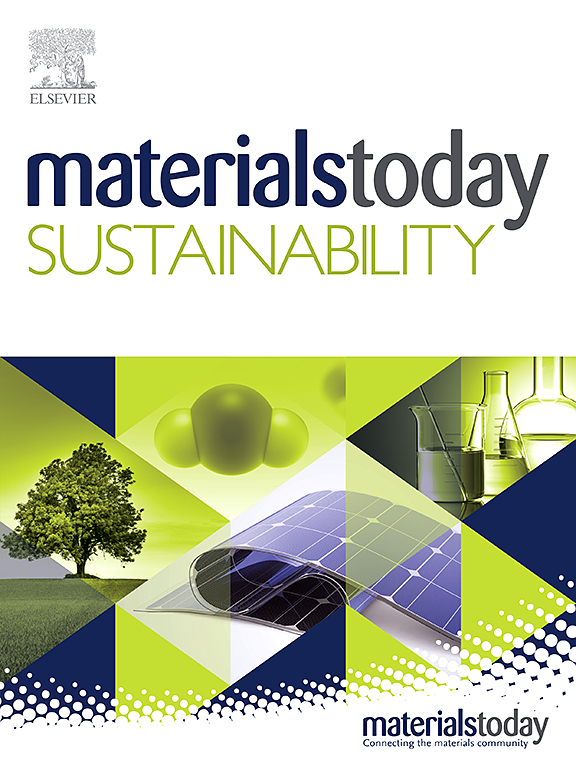阐明TMDC-TMN逐层沉积对超级电池器件优异电化学性能的协同作用
IF 7.1
3区 材料科学
Q1 GREEN & SUSTAINABLE SCIENCE & TECHNOLOGY
引用次数: 0
摘要
超级电容装置可以结合电池和超级电容器的优点,解决它们在功率和能量密度方面的各自限制。本研究的重点是通过战略性地加入过渡金属二硫化物和过渡金属氮化物,特别是二硫化钨,来提高电池级电极的电化学性能。利用磁控溅射技术,我们将氮化铬和氮化钛导电层集成在衬底和WS2之间。电化学测试结果表明,WS2的初始比容量(Qs)为600 C/g。然而,通过加入CrN和TiN的界面层,Qs显著提高了830 C/g和1230 C/g,表明界面工程对WS2的整体性能有实质性影响。所制备的超电容器件表现出优异的性能,其中WS2/CrN//AC的q值达到950 C/g, WS2/TiN//AC的q值达到1100 C/g。此外,WS2/CrN//AC和WS2/TiN//AC的功率密度分别达到6800 W/kg(容量保持率99.8%)和7108 W/kg(容量保持率99.9%),能量密度分别为98 Wh/kg和135 Wh/kg,显示了WS2/TiN//AC优越的性能和稳定性。此外,为了研究器件的扩散和电容行为,进一步使用了两种不同的半经验模型并进行了比较。这项工作强调了界面工程在提高混合储能系统性能方面的潜力。本文章由计算机程序翻译,如有差异,请以英文原文为准。

Elucidating the synergy of layer-by-layer TMDC-TMN deposition for superior electrochemical performance in supercapattery devices
Supercapatteric devices can combine the advantages of batteries and supercapacitors, addressing their individual limitations in power and energy density. This study focuses on enhancing the electrochemical performance of battery-grade electrodes through the strategic incorporation of transition metal dichalcogenides and transition metal nitrides, specifically tungsten disulfide. Utilizing the magnetron sputtering, we integrated conductive layers of chromium nitride and titanium nitride between substrate and WS2. Results of thorough electrochemical testing revealed that the initial specific capacity (Qs) of WS2 was 600 C/g. However, by incorporating interfacial layers of CrN and TiN, the Qs was significantly improved 830 C/g and 1230 C/g, demonstrating the substantial impact of interface engineering on overall performance of WS2. The fabricated supercapatteric devices, demonstrated exceptional performance, with WS2/CrN//AC achieving Qs of 950 C/g and WS2/TiN//AC reaching a Qs of 1100 C/g. Moreover, WS2/CrN//AC and WS2/TiN//AC attained power densities of 6800 W/kg (with 99.8 % capacity retention) and 7108 W/kg (with 99.9 % capacity retention), respectively, and energy densities of 98 Wh/kg and 135 Wh/kg, highlighting the superior performance and stability of WS2/TiN//AC. Additionally, for examining the diffusive and capacitive behaviors of devices, two different semi-empirical models were further used and compared. This work emphasizes the potential of interface engineering in enhancing the performance of hybrid energy storage (HES) systems.
求助全文
通过发布文献求助,成功后即可免费获取论文全文。
去求助
来源期刊

Materials Today Sustainability
Multiple-
CiteScore
5.80
自引率
6.40%
发文量
174
审稿时长
32 days
期刊介绍:
Materials Today Sustainability is a multi-disciplinary journal covering all aspects of sustainability through materials science.
With a rapidly increasing population with growing demands, materials science has emerged as a critical discipline toward protecting of the environment and ensuring the long term survival of future generations.
 求助内容:
求助内容: 应助结果提醒方式:
应助结果提醒方式:


